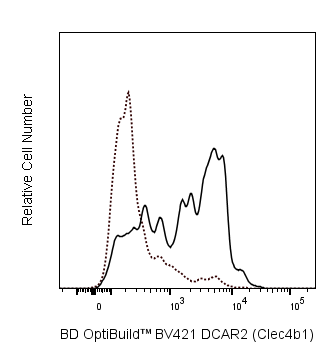Old Browser
This page has been recently translated and is available in French now.
Looks like you're visiting us from {countryName}.
Would you like to stay on the current country site or be switched to your country?




Flow cytometric analysis using BD OptiBuild™ BV421 Rat Anti-Mouse DCAR2 (Clec4b1) antibody (Cat. No. 750909; solid line, left panel) on live conventional dentritic cells of C57/Bl6 mouse bone marrow cells and on live DCAR2-transfected 293F cells (solid line, right parnel) with Isotype Control and untreated cells (dotted line accordingly). Flow cytometry was performed using a BD LSRFortessa™ X-20 Flow Cytometer System.


BD OptiBuild™ BV421 Rat Anti-Mouse DCAR2 (Clec4b1)

Regulatory Status Legend
Any use of products other than the permitted use without the express written authorization of Becton, Dickinson and Company is strictly prohibited.
Preparation And Storage
Recommended Assay Procedures
BD™ CompBeads can be used as surrogates to assess fluorescence spillover (Compensation). When fluorochrome conjugated antibodies are bound to BD CompBeads, they have spectral properties very similar to cells. However, for some fluorochromes there can be small differences in spectral emissions compared to cells, resulting in spillover values that differ when compared to biological controls. It is strongly recommended that when using a reagent for the first time, users compare the spillover on cells and BD CompBead to ensure that BD CompBeads are appropriate for your specific cellular application.
For optimal and reproducible results, BD Horizon Brilliant Stain Buffer should be used anytime two or more BD Horizon Brilliant dyes are used in the same experiment. Fluorescent dye interactions may cause staining artifacts which may affect data interpretation. The BD Horizon Brilliant Stain Buffer was designed to minimize these interactions. More information can be found in the Technical Data Sheet of the BD Horizon Brilliant Stain Buffer (Cat. No. 563794/566349) or the BD Horizon Brilliant Stain Buffer Plus (Cat. No. 566385).
Product Notices
- The production process underwent stringent testing and validation to assure that it generates a high-quality conjugate with consistent performance and specific binding activity. However, verification testing has not been performed on all conjugate lots.
- Researchers should determine the optimal concentration of this reagent for their individual applications.
- An isotype control should be used at the same concentration as the antibody of interest.
- Caution: Sodium azide yields highly toxic hydrazoic acid under acidic conditions. Dilute azide compounds in running water before discarding to avoid accumulation of potentially explosive deposits in plumbing.
- For fluorochrome spectra and suitable instrument settings, please refer to our Multicolor Flow Cytometry web page at www.bdbiosciences.com/colors.
- Please refer to www.bdbiosciences.com/us/s/resources for technical protocols.
- BD Horizon Brilliant Stain Buffer is covered by one or more of the following US patents: 8,110,673; 8,158,444; 8,575,303; 8,354,239.
- Please refer to http://regdocs.bd.com to access safety data sheets (SDS).
- Pacific Blue™ is a trademark of Molecular Probes, Inc., Eugene, OR.
- BD Horizon Brilliant Violet 421 is covered by one or more of the following US patents: 8,158,444; 8,362,193; 8,575,303; 8,354,239.
Companion Products






The 7D2D3 monoclonal antibody specifically recognizes mouse Dendritic Cell Activating Receptor 2 (DCAR2), a C-type lectin encoded by the Clec4b1 gene. DCAR2 (Clec4b1) is a member of the dendritic cell immunoreceptor (DCIR) family, which contains four dendritic cell inhibitory receptors (DCIR1-4) and two activating receptors (DCAR1, 2). The extracellular region of DCAR2 (Clec4b1) has one C-type lectin carbohydrate recognition domain (CRD), that is highly similar to that of DCIR1, followed by a transmembrane region. Instead of a cytoplasmic Immunoreceptor Tyrosine-based Inhibitory Motif (ITIM) that can transmit inhibitory signals, DCAR2 associates with the Immunoreceptor Tyrosine-based Activating Motif (ITAM)-containing adaptor molecule, Fc Receptor γ (FcRγ). DCAR2 (Clec4b1) is expressed on restricted subsets of conventional dendritic cells in bone marrow and skin-draining lymph nodes. C-type lectins bind to carbohydrates in a calcium-dependent manner, and this receptor may be involved in the regulation of immune responses to bacterial infections.
The antibody was conjugated to BD Horizon™ BV421 which is part of the BD Horizon Brilliant™ Violet family of dyes. With an Ex Max of 407-nm and Em Max at 421-nm, BD Horizon BV421 can be excited by the violet laser and detected in the standard Pacific Blue™ filter set (eg, 450/50-nm filter). BD Horizon BV421 conjugates are very bright, often exhibiting a 10 fold improvement in brightness compared to Pacific Blue conjugates.

Development References (4)
-
Hsu Y, Okada R, Nishimura T, Kawasaki N, Yamamoto K, Matsumoto N. DCIR3 and DCIR4 are co-expressed on inflammatory and patrolling monocytes. Biochem Biophys Res Commun.. 2017; 494(3-4):440-445. (Clone-specific: Flow cytometry). View Reference
-
Kanazawa N, Tashiro K, Inaba K, Miyachi Y. Dendritic cell immunoactivating receptor, a novel C-type lectin immunoreceptor, acts as an activating receptor through association with Fc receptor gamma chain.. J Biol Chem. 2003; 278(35):32645-52. (Biology). View Reference
-
Kishimoto A, Watanabe M, Terauchi K, et al. Ubiquitous versus restricted expression of the two mouse dendritic cell C-type lectin receptors, DCIR1 and DCAR2, among myeloid cells.. Biochem Biophys Res Commun. 2015; 467(2):383-8. (Immunogen: Flow cytometry). View Reference
-
Toyonaga K, Torigoe S, Motomura Y, et al. C-Type Lectin Receptor DCAR Recognizes Mycobacterial Phosphatidyl-Inositol Mannosides to Promote a Th1 Response during Infection. Immunity. 2016; 45(6):1245-1257. (Biology). View Reference
Please refer to Support Documents for Quality Certificates
Global - Refer to manufacturer's instructions for use and related User Manuals and Technical data sheets before using this products as described
Comparisons, where applicable, are made against older BD Technology, manual methods or are general performance claims. Comparisons are not made against non-BD technologies, unless otherwise noted.
For Research Use Only. Not for use in diagnostic or therapeutic procedures.
Report a Site Issue
This form is intended to help us improve our website experience. For other support, please visit our Contact Us page.